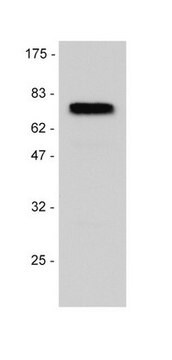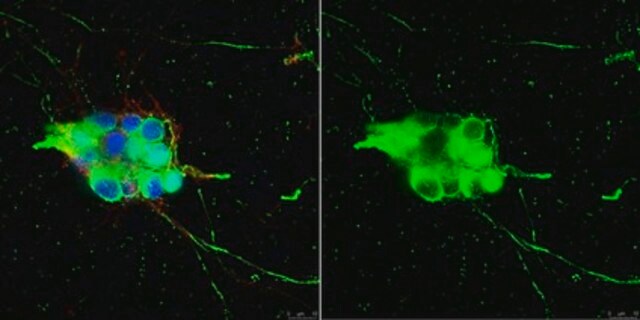ABN1655
Anti-p75NTR Antibody, ICD
serum, from rabbit
Synonim(y):
Tumor necrosis factor receptor superfamily member 16, CD271, Gp80-LNGFR, Low-affinity nerve growth factor receptor, Low affinity neurotrophin receptor p75NTR, NGF receptor, p75 ICD
About This Item
Polecane produkty
pochodzenie biologiczne
rabbit
Poziom jakości
forma przeciwciała
serum
rodzaj przeciwciała
primary antibodies
klon
polyclonal
reaktywność gatunkowa
chicken, mouse, human, rat
metody
immunocytochemistry: suitable
immunofluorescence: suitable
immunoprecipitation (IP): suitable
western blot: suitable
numer dostępu NCBI
numer dostępu UniProt
Warunki transportu
ambient
docelowa modyfikacja potranslacyjna
unmodified
informacje o genach
rat ... Ngfr(24596)
Opis ogólny
Specyficzność
Immunogen
Zastosowanie
Immunofluorescence Analysis: A representative lot localized p75ICD immunoreactivity in cryosections from various stages of chick embryos fixed with 4% paraformaldehyde and permeabilized by 0.1% Triton X-100 (López-Sánchez, N., et al. (2007). Physiol. Genomics. 30(2):156-171).
Immunoprecipitation Analysis: A representative lot co-immunoprecipitated NRIF with p75 from rat sympathetic neurons. Co-immunoprecipitation of exogenously expressed NRIF and p75 by this antiserum was also seen using 293 transfectant. Increased CTF and ICD fragments were immunoprecipitated from PMA-treated 293 transfectants and from BDNF-treated neurons (in the presence of proteasome inhibitor). Co-treatment with gamma-secretase inhibitor abolished ICD, but not CTF cleavage in PMA- and BDNF-treated cells (Kenchappa, R.S., et al. (2006). Neuron. 50(2):219-232).
Western Blotting Analysis: A representative lot detected p75 in rat sympathetic neurons. Increased ~30 kDa CTF and ~25 kDa ICD fragments were detected from BDNF- or PMA-, but not NGF-, treated neurons (in the presence of proteasome inhibitor). Co-treatment with gamma-secretase inhibitor abolished ICD, but not CTF cleavage in BDNF-treated cells (Kenchappa, R.S., et al. (2006). Neuron. 50(2):219-232).
Western Blotting Analysis: A representative lot detected p75 in superior cervical ganglia (SCG) whole tissue lysate from P4 and P24 postnatal rats. CTF and ICD fragments were detected only in P4, but not P24 SCG lysate (Kenchappa, R.S., et al. (2006). Neuron. 50(2):219-232).
Neuroscience
Jakość
Western Blotting Analysis: A 1:5,000 dilution of this antiserum detected the ~25 kDa p75NTR (neurotrophin receptor) ICD fragment in 10 µg of mouse retina tissue lysate.
Opis wartości docelowych
Postać fizyczna
Przechowywanie i stabilność
Handling Recommendations: Upon receipt and prior to removing the cap, centrifuge the vial and gently mix the solution. Aliquot into microcentrifuge tubes and store at -20°C. Avoid repeated freeze/thaw cycles, which may damage IgG and affect product performance.
Inne uwagi
Oświadczenie o zrzeczeniu się odpowiedzialności
Nie możesz znaleźć właściwego produktu?
Wypróbuj nasz Narzędzie selektora produktów.
Kod klasy składowania
12 - Non Combustible Liquids
Klasa zagrożenia wodnego (WGK)
WGK 1
Certyfikaty analizy (CoA)
Poszukaj Certyfikaty analizy (CoA), wpisując numer partii/serii produktów. Numery serii i partii można znaleźć na etykiecie produktu po słowach „seria” lub „partia”.
Masz już ten produkt?
Dokumenty związane z niedawno zakupionymi produktami zostały zamieszczone w Bibliotece dokumentów.
Nasz zespół naukowców ma doświadczenie we wszystkich obszarach badań, w tym w naukach przyrodniczych, materiałoznawstwie, syntezie chemicznej, chromatografii, analityce i wielu innych dziedzinach.
Skontaktuj się z zespołem ds. pomocy technicznej






